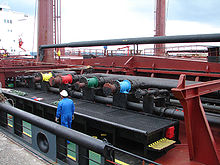Manifold (shipbuilding)
A manifold (German: hose connection station) is used on tankers to connect the pipes or hoses required for cargo handling. A tanker usually has a hose connection station on both sides. Inland vessels usually have three connections, fore, midships and aft, on both sides.
The individual manifolds usually have several pipe ends with standardized flanges to which the movable pipe arms (e.g. Chiksan arms ) of a terminal or hoses are connected for loading or unloading the cargo . Depending on the type and size of the tanker, the hose connection station is equipped with various communication devices to the pump room and the bridge of the ship. Furthermore, the manifold has cranes or loading booms for taking over hoses and components and safety devices, for example to quickly close the valves in the event of overflows, fire extinguishing systems and permanently installed or mobile oil leak pans to catch leaks.
literature
- Helmers, Walter (ed.): Müller-Krauss, manual for ship management . Volume 3, Ship Safety, Part A. Springer Verlag, Berlin 1980, ISBN 3-540-09883-6 .
